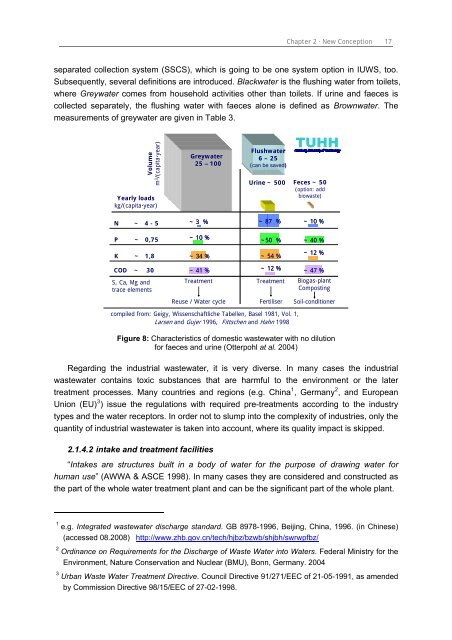Chapter 3 Decision Support Model (IUWS-DSM) - Tubdok
Chapter 3 Decision Support Model (IUWS-DSM) - Tubdok
Chapter 3 Decision Support Model (IUWS-DSM) - Tubdok
Create successful ePaper yourself
Turn your PDF publications into a flip-book with our unique Google optimized e-Paper software.
<strong>Chapter</strong> 2 · New Conception 17<br />
separated collection system (SSCS), which is going to be one system option in <strong>IUWS</strong>, too.<br />
Subsequently, several definitions are introduced. Blackwater is the flushing water from toilets,<br />
where Greywater comes from household activities other than toilets. If urine and faeces is<br />
collected separately, the flushing water with faeces alone is defined as Brownwater. The<br />
measurements of greywater are given in Table 3.<br />
Volume<br />
m3 /(capita�year)<br />
Yearly loads<br />
kg/(capita�year)<br />
Greywater<br />
25 – 100<br />
Urine ~ 500 Feces ~ 50<br />
(option: add<br />
biowaste)<br />
N ~ 4 - 5 ~ 3 % ~ 87 % ~ 10 %<br />
P ~ 0,75 ~ 10 %<br />
~50 % ~ 40 %<br />
K ~ 1,8 ~ 34 %<br />
~ 54 %<br />
COD ~ 30 ~ 41 %<br />
S, Ca, Mg and<br />
trace elements<br />
Treatment<br />
Reuse / Water cycle<br />
Flushwater<br />
6 – 25<br />
(can be saved)<br />
~ 12 %<br />
~ 12 % ~ 47 %<br />
Treatment<br />
Fertiliser<br />
compiled from: Geigy, Wissenschaftliche Tabellen, Basel 1981, Vol. 1,<br />
Larsen and Gujer 1996, Fittschen and Hahn 1998<br />
Biogas-plant<br />
Composting<br />
Soil-conditioner<br />
Figure 8: Characteristics of domestic wastewater with no dilution<br />
for faeces and urine (Otterpohl at al. 2004)<br />
Regarding the industrial wastewater, it is very diverse. In many cases the industrial<br />
wastewater contains toxic substances that are harmful to the environment or the later<br />
treatment processes. Many countries and regions (e.g. China 1 , Germany 2 , and European<br />
Union (EU) 3 ) issue the regulations with required pre-treatments according to the industry<br />
types and the water receptors. In order not to slump into the complexity of industries, only the<br />
quantity of industrial wastewater is taken into account, where its quality impact is skipped.<br />
2.1.4.2 intake and treatment facilities<br />
“Intakes are structures built in a body of water for the purpose of drawing water for<br />
human use” (AWWA & ASCE 1998). In many cases they are considered and constructed as<br />
the part of the whole water treatment plant and can be the significant part of the whole plant.<br />
1<br />
e.g. Integrated wastewater discharge standard. GB 8978-1996, Beijing, China, 1996. (in Chinese)<br />
(accessed 08.2008) http://www.zhb.gov.cn/tech/hjbz/bzwb/shjbh/swrwpfbz/<br />
2<br />
Ordinance on Requirements for the Discharge of Waste Water into Waters. Federal Ministry for the<br />
Environment, Nature Conservation and Nuclear (BMU), Bonn, Germany. 2004<br />
3<br />
Urban Waste Water Treatment Directive. Council Directive 91/271/EEC of 21-05-1991, as amended<br />
by Commission Directive 98/15/EEC of 27-02-1998.

















